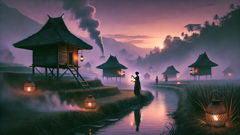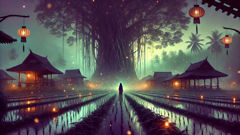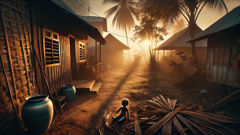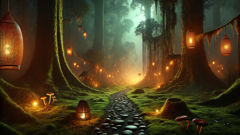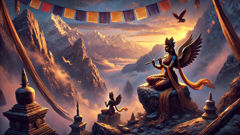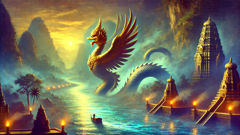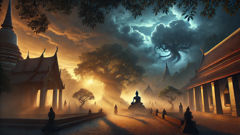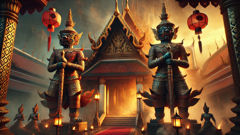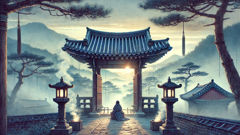Introduction
Mist curled through the ancient beech and rimu groves of Aotearoa’s southern mountains, shrouding the forest floor in secrets older than memory. In these wild, untamed places, where sunlight barely slipped through the dense canopy and the air hummed with the songs of hidden creatures, the land seemed to breathe with its own spirit. For countless generations, the Maori people gazed at these shadowed hills and valleys with a deep sense of awe and caution, knowing that their ancestors’ stories had marked these woods as the realm of the Maero—the wild giants of legend. The Maero, it was said, were beings woven from the raw fabric of the land itself: towering creatures covered in thick, dark hair, with fierce eyes that glowed like embers beneath the trees. They were older than the arrival of humankind, guardians and terrors of the mountains and forests, whose anger could split rocks and whose sadness could turn rivers to mist. The world before humans was their domain, and their presence lingered long after the first canoes touched New Zealand’s shores. To the Maori, the Maero were not mere monsters; they embodied the untamable, mysterious heart of nature. Their stories were warnings and wisdom, reminders that the wild had its own laws, its own guardians. Children learned to respect the bush not only for its bounty but for its dangers—the echo of a branch snapping in the dusk, the chill in the air at dawn, these were signs that the Maero might be near. Over time, the Maero became more than figures of fear. They were woven into the whakapapa—the genealogy of the land—part of the living memory that shaped every river and peak. Some said they watched from the ridgelines, eyes glinting with sorrow at the changes humans brought. Others believed the Maero’s spirit could still be felt in lonely places, guiding those who walked with respect and humility, and punishing those who dared to offend the tapu, the sacred order of nature. In the legend of the Maero lies the pulse of Aotearoa’s wild soul: a story of giants and spirits, of struggle and coexistence, of the ancient dance between humankind and the land itself.
Whispers in the Wild: The First Encounters
Long before the arrival of the first Maori waka, the land that would become known as Aotearoa was a kingdom of shadow and green. The mountains rose in jagged, silent majesty, and rivers cut deep through mossy valleys. In these ancient times, the Maero reigned. They were not beings of gentle disposition; they belonged to the wildness itself. Some said their birth came from the earliest winds that swept across the land, gathering earth and shadow to form bodies taller than the tallest totara, limbs knotted like old roots, and hair as dark as a raven’s wing. Each Maero was different—some lean and wolfish, others hunched and massive, but all were bound by a deep connection to the heart of the land.
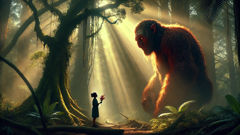
They were solitary, mistrustful of others, even their own kind. The forest was their fortress, a tangle of shadows and silence where they moved unseen, save for a fleeting glimpse of a huge shape melting between the trees. Animals—weka, kiwi, and kereru—scattered at their scent, for the Maero were hunters by necessity. Yet, unlike the careless creatures that sometimes trampled saplings, the Maero took only what they needed, always leaving an offering of fern or stone to the forest. In this way, they kept an ancient balance, a pact with the land that sustained them.
When the first Maori navigators arrived from Hawaiki, they brought with them fire, crops, and their own gods. The Maero watched in silence, their amber eyes peering from behind curtains of moss. At first, there was distance. The new people kept to the riverbanks and lowlands, building their whare beneath the open sky, singing songs that drifted on the evening breeze. The Maero circled these settlements, curious yet wary, their enormous footprints pressed into damp earth where no human dared to walk.
It was in the season of mists that the first meeting occurred. Hinewai, a young woman gathering berries in a forest clearing, heard a deep, rumbling growl behind her. Turning slowly, she saw a figure step from the shadows—taller than any man, wild and hair-covered, yet with sorrow etched in his features. She did not run; instead, she offered a handful of ripe berries, her voice soft and steady. The Maero accepted her gift with a grunt, his huge hand swallowing the berries whole, and vanished back into the bush. Hinewai returned to her village that night, trembling but unharmed. Her story spread like wildfire: the Maero were real.
Some elders whispered that the Maero were spirits to be appeased. Others feared their anger—stories grew of men who mocked the forest or hunted recklessly, never to be seen again. Sometimes, deep in the night, villagers heard the haunting howl of a Maero, echoing through the valleys, and shuttered their windows against the dark. Yet not all encounters ended in terror. There were tales of lost children guided to safety by enormous, hairy hands, or of hunters spared when a Maero deemed their cause worthy. It became clear that the Maero were not simply monsters, but guardians—protectors of the old ways, keepers of balance between humankind and nature.
Clash and Consequence: The Struggle for the Mountains
As the years passed, human settlement spread like a slow tide up into the hills and valleys. The forests were no longer silent—axes rang against wood, smoke curled from new villages, and paths cut through groves that had never known a human foot. The Maero, unused to such disturbance, grew restless. Their hunting grounds shrank, and the rivers they revered became muddied by silt and careless hands.
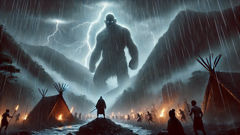
It began with small acts. A Maero was seen at dusk, scattering firewood piled for winter. Another left claw marks on a newly carved canoe. The Maori, respectful but proud, responded with offerings and prayers, but sometimes fear gave way to anger. Warriors boasted of hunting the wild giants, and songs were sung of ancestors who faced the Maero with courage—or cunning.
The most famous clash came on a night of pounding rain and thunder. A chief named Te Ariki led his people into the mountains to clear land for new gardens. As they slept, a Maero named Rakuraku crept down from the ridgeline, his eyes burning with fury. He tore through the camp, uprooting stakes and tossing them into the river. The villagers awoke in chaos. Some fled, others fought with spears and shouts, but Rakuraku was as strong as a landslide. Only when Hinewai—older now, respected for her wisdom—stood between the giant and her people did the violence cease.
Hinewai spoke to Rakuraku not with weapons but with words, honoring his place in the world and pleading for peace. She promised that her people would respect the tapu of the mountain, leaving sacred groves untouched and rivers clean. In return, Rakuraku relented, melting back into the darkness. From that night onward, a fragile truce held. Boundaries were marked not with fences but with carved posts—pou—set deep in the earth, signifying respect for the Maero’s realm.
Yet not all Maero agreed with this compromise. Some, embittered by loss, lashed out at unwary travelers. There were stories of entire hunting parties vanishing, or of chilling footprints found beside bloodstained streams. The elders taught their children to move quietly, never to take more than was needed, and always to speak words of gratitude to the forest. These lessons were not just for survival—they were an act of remembrance, an acknowledgment that humans were guests in a world far older and wilder than themselves.
In time, the worst of the violence faded. The Maero retreated to deeper forests, their numbers dwindling as the world changed around them. But for every tragedy, there was a story of mercy: a lost child returned to her family by a shadowy guide; a hunter who found meat left on his path after days of hunger. The Maero had become both legend and warning—a reminder that the land itself had a voice, and that voice demanded respect.
Echoes and Endurance: The Maero in Memory
With each passing generation, the forests grew quieter and human settlements more permanent. The Maero faded from daily sight, but their legend became woven into the heart of Aotearoa’s culture. Some said the last Maero vanished with the clearing of the deepest bush; others whispered that they simply learned to move unseen, watching from hidden caves or blending with the mist on lonely mornings.
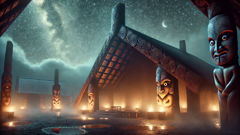
Yet even as their physical presence diminished, the Maero’s spirit endured. Storytellers invoked their names around winter fires, warning children not to wander too far into the forest or to waste the bounty of the land. Carvings on marae depicted hairy giants with mournful eyes, forever guarding the mountain passes. And every so often, hunters reported finding enormous footprints in soft earth, or hearing a guttural call echoing through dawn’s fog.
For the Maori, the Maero became more than cautionary tales. They were guardians of tapu, embodiments of nature’s strength and unpredictability. Their memory reinforced the belief that all life—human, animal, plant—was interconnected through whakapapa, a sacred genealogy stretching back to the first breath of creation. The Maero, in this view, were neither wholly good nor evil, but essential actors in the great drama of existence.
In later years, as European settlers arrived and reshaped the land once more, the legend of the Maero took on new meanings. Some dismissed them as superstition; others saw in them a symbol of resistance—a wildness that could not be tamed or owned. The Maero became part of a larger conversation about belonging and responsibility. Their stories reminded people that every tree felled or river dammed came with a cost, and that the land’s ancient guardians might still be watching.
Today, in remote valleys and along forgotten trails, it’s said that the Maero’s spirit lingers. A sudden hush in the trees, a cold breath of wind on a warm day, the sense of being watched—these are signs that the wild giants have not entirely left. For those who walk with care, honoring the old ways and treating the land with reverence, the Maero remain silent allies. But for those who forget, who trample or take without thought, the legend offers a warning: nature remembers.
Conclusion
The legend of the Maero endures because it speaks to something timeless within us—a recognition of nature’s power, mystery, and spirit. As long as forests stand and mountains rise in Aotearoa, their story will ripple through the land like mist through ancient trees. The Maero remind us to walk gently, to honor the balance between taking and giving, and to respect the wild not as an enemy but as a wise and ancient relative. Though their form may have faded into myth, their presence remains: in every shadowed glen, every shiver of wind through the trees, and in every story whispered by firelight. In remembering the Maero, we remember our duty to care for the land and to listen for the voices that dwell just beyond sight. Their legend is not only a tale of fear or awe—it’s a promise that the spirit of Aotearoa’s wild places is alive, waiting for those who seek it with humble hearts.


